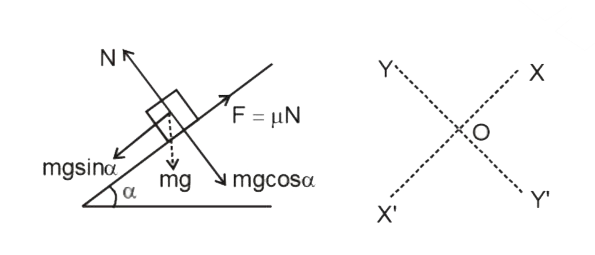A body is sliding down an inclined plane forming an angle 30∘ with the horizantal. If the coefficient of friction is0.3 then acceleration of the body is
1.25.ms−2
2.35ms−2
3.4ms−2
4.9ms−2
The correct Answer is:B
To find the acceleration of a body sliding down an inclined plane at an angle of 30∘ with a coefficient of friction of 0.3, we can follow these steps:
Step 1: Identify the forces acting on the body
The forces acting on the body are:
1. Gravitational force (Mg) acting downwards.
2. Normal force (N) acting perpendicular to the inclined plane.
3. Frictional force (f) acting opposite to the direction of motion.
Step 2: Resolve the gravitational force into components
The gravitational force can be resolved into two components:
- Parallel to the incline: Fparallel=Mgsinθ
- Perpendicular to the incline: Fperpendicular=Mgcosθ
Given θ=30∘:
- Fparallel=Mgsin30∘=Mg⋅12=Mg2
- Fperpendicular=Mgcos30∘=Mg⋅√32=Mg√32
Step 3: Calculate the normal force
The normal force N is equal to the perpendicular component of the gravitational force:
N=Fperpendicular=Mgcos30∘=Mg√32
Step 4: Calculate the frictional force
The frictional force can be calculated using the coefficient of friction (μ):
f=μN=0.3⋅N=0.3⋅Mg√32=0.3Mg√32
Step 5: Write the equation of motion
The net force acting on the body along the incline is given by:
Fnet=Fparallel−f
Substituting the values we found:
Fnet=Mg2−0.3Mg√32
Step 6: Factor out M and simplify
Factoring out M from the equation:
Fnet=M2(g−0.3g√3)
Step 7: Calculate acceleration
Using Newton's second law, F=ma, we can express acceleration a as:
a=FnetM=12(g−0.3g√3)
Substituting g=10m/s2:
a=12(10−0.3⋅10⋅√3)
Calculating 0.3⋅10⋅√3≈5.196:
a=12(10−5.196)≈12⋅4.804≈2.402m/s2
Final Answer
The acceleration of the body is approximately 2.4m/s2.
---
The forces acting on the body are:
1. Gravitational force (Mg) acting downwards.
2. Normal force (N) acting perpendicular to the inclined plane.
3. Frictional force (f) acting opposite to the direction of motion.
The gravitational force can be resolved into two components:
- Parallel to the incline: Fparallel=Mgsinθ
- Perpendicular to the incline: Fperpendicular=Mgcosθ
- Fparallel=Mgsin30∘=Mg⋅12=Mg2
- Fperpendicular=Mgcos30∘=Mg⋅√32=Mg√32
The normal force N is equal to the perpendicular component of the gravitational force:
N=Fperpendicular=Mgcos30∘=Mg√32
The frictional force can be calculated using the coefficient of friction (μ):
f=μN=0.3⋅N=0.3⋅Mg√32=0.3Mg√32
The net force acting on the body along the incline is given by:
Fnet=Fparallel−f
Substituting the values we found:
Fnet=Mg2−0.3Mg√32
Factoring out M from the equation:
Fnet=M2(g−0.3g√3)
Using Newton's second law, F=ma, we can express acceleration a as:
a=FnetM=12(g−0.3g√3)
Substituting g=10m/s2:
a=12(10−0.3⋅10⋅√3)
Calculating 0.3⋅10⋅√3≈5.196:
a=12(10−5.196)≈12⋅4.804≈2.402m/s2
The acceleration of the body is approximately 2.4m/s2.
Topper's Solved these Questions
- CIRCULAR MOTIONBOOK - NARAYNACHAPTER - CIRCULAR MOTIONEXERCISE - LEVEL II(H.W)
51 Videos
- CIRCULAR MOTIONBOOK - NARAYNACHAPTER - CIRCULAR MOTIONEXERCISE - IIT QUES.
4 Videos
- CALORIMETRYBOOK - NARAYNACHAPTER - CALORIMETRYEXERCISE - Level- II (H.W)
11 Videos
- COLLISIONBOOK - NARAYNACHAPTER - COLLISIONEXERCISE - Level-II (H.W)
54 Videos
Similar Questions
A body of mass 5×10−3 kg is launched upon a rough inclined plane making an angle of 30∘ with the horizontal. Obtain the coefficient of friction between the body and the plane if the time of ascent is half of the time of descent.
View SolutionA body of mass 5×10−3kg is launched upon a rough inclined plane making an angle of 30° with the horizontal. Find the coefficient of friction between the body and the plane if the time of ascent is half of the time of descent.
View Solution
Knowledge Check
A body is sliding down an inclined plane forming an angle 30∘ with the horizontal. If the coefficient of friction is 0.3 then acceleration of the body is
A1.25ms−2B2.35ms−2C3.4ms−2D4.9ms−2A body of mass m slides down an inclined plane making an angle of 45∘ with the horizontal. If the coefficient of friction between the body and the plane be 0.3, the acceleration of the body is approximately equal to :
A0.22 gB0.30 gC0.49 gD0.70 gA body of mass 10 kg is lying on a rough plane inclined at an angle of 30∘ to the horizontal and the coefficient of friction is 0.5. the minimum force required to pull the body up the plane is
A914 NB91.4 NC9.14 ND0.914 N
A block slides down an incline of angle 30∘ with an acceleration of g/4 Find the coefficient of kinetic friction .
View SolutionA 20kg box is gently placed on a rough inclined plane of inclination 30∘ with horizontal. The coefficient of sliding friction between the box and the plane is 0.5.Find the acceleration of the box down the incline.

View SolutionA block slides down on inclined plane (angle of inclination 60∘ ) with an accelration g/2 Find the coefficient friction

View SolutionA body of mass 5×10−3 kg is launched upon a rough inclined plane making an angle of 30∘ with the horizontal. Obtain the coefficient of friction between the body and the plane if the time of ascent is half of the time of descent.
View SolutionA block rests on an inclined plane that makes an angle with the horizontal, if the coefficient of sliding friction is 0.50 and that of static friction is 0.75, the time required to slide the block 4 m along the inclined plane is -
View Solution